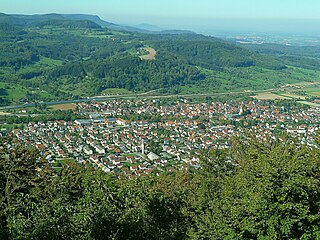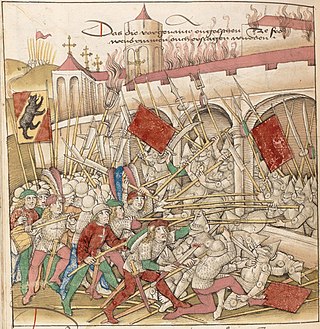Related Research Articles

The coat of arms of the Republic of Croatia consists of one main shield and five smaller shields which form a crown over the main shield. The main coat of arms is a checkerboard (chequy) that consists of 13 red and 12 white fields. It is also informally known in Croatian as šahovnica. The five smaller shields represent five different historical regions within Croatia.

Madiswil is a municipality in the Oberaargau administrative district in the canton of Bern in Switzerland. Since January 1, 2007, Gutenburg is part of the municipality. On 1 January 2011 Kleindietwil and Leimiswil were merged with the municipality of Madiswil.

Melchnau is a municipality in the Oberaargau administrative district in the canton of Bern in Switzerland.

Reisiwil is a municipality in the Oberaargau administrative district in the canton of Bern in Switzerland.

Gingen an der Fils is a municipality in the district of Göppingen in Baden-Württemberg, Germany.

The Guglers were a body of mostly English and French knights who as mercenaries invaded Alsace and the Swiss plateau under the leadership of Enguerrand VII de Coucy during the Gugler War of 1375.

The coat of arms of Dalmatia is the heraldic symbol used for the historical region of Dalmatia on the eastern coast of Adriatic Sea. It is also featured on the crest of the coat of arms of Croatia. The arms have three golden lion heads, facing front, with golden crowns and red tongues, on a blue shield. The blazon, or formal heraldic description, isazure, with three crowned golden leopards' heads affrontés caboshed Or, langued in gules. The Lions' heads affrontés were historically referred to as leopards, but this refers to their pose rather than species.
New Gothic or Neo-Gothic is a contemporary art movement that emphasizes darkness and horror.

The ruins of Grünenberg Castle, Schnabelburg Castle and Langenstein Castle are a complex of three interconnected castles on a hill above the municipality of Melchnau in the canton of Bern in Switzerland. The three castles formed the center of power of the Barons of Grünenberg in the Oberaargau region during the High Middle Ages.

The Langenstein family is an extinct Swiss noble family that came from Langenstein Castle in Melchnau in the Canton of Bern in Switzerland. Only two generations of the family are known. In 1194 the family helped found the Cistercian St. Urban's Abbey. The family became extinct in the early 13th century, though much of their land was inherited by the Grünenbergs.

The Grünenberg family was a medieval Swiss noble family. The family was active from the middle of the 12th century until the 15th century in the Swiss Plateau, mostly in the Bernese Oberaargau. There were two major branches, the Grimme and Schnabel lines which then further divided into other branches. Some of these branches owned land in Alsace and in southern Bavaria, especially in the Markgräflerland and in Breisgau. About one hundred members of the family are known today. The family name comes from Grünenberg Castle in Melchnau in the Canton of Bern.
In heraldry, a mount is a representation of a hill or mountain as a curved terrace in base. When the mount is included in the lower part of the shield, it may be considered an ordinary rather than a charge.

Glasperlenspiel is a German electropop duo from Stockach, consisting of vocalist Carolin Niemczyk, and keyboardist Daniel Grunenberg.

Conrad Grünenberg, also spelled Konrad, Grünemberg, Grünberg was a patrician from Constance in southern Germany, known as the author of three books, two armorials and a travelogue: the Österreichische Wappenchronik ; the Wappenbuch, containing some 2000 coats-of-arms, which he presented as a gift to Emperor Frederick III; and the illustrated description of his 1486 pilgrimage to Jerusalem.

Rahel Varnhagen: The Life of a Jewess is a biography of Rahel Varnhagen written by political philosopher Hannah Arendt. Originally her Habilitationsschrift she completed it in exile as a refugee, but was not published till 1957, in English, in the UK (London) by East and West Library.
Antonia Grunenberg is a German political scientist, totalitarianism researcher and an expert on the political thought of Hannah Arendt. She is professor emerita at the University of Oldenburg, where she taught as a full professor from 1998 until her 2009 retirement, and where she was director of the Hannah Arendt Centre. She is also editor of the book series Hannah Arendt Studies.

Anna Deparnay-Grunenberg is a German politician of Alliance 90/The Greens who served as a Member of the European Parliament from 2019 to 2024.
Niels Grunenberg is a German Paralympic swimmer. He represented Germany at the 2008 Summer Paralympics and at the 2012 Summer Paralympics and he won the silver medal in the men's 100 metres breaststroke SB5 event in 2012.
Compliance constants are the elements of an inverted Hessian matrix. The calculation of compliance constants provides an alternative description of chemical bonds in comparison with the widely used force constants explicitly ruling out the dependency on the coordinate system. They provide the unique description of the mechanical strength for covalent and non-covalent bonding. While force constants are usually given in aJ/Å2 or N/cm, compliance constants are given in Å2/aJ or Å / mdyn.
Nina Grunenberg was a German author and prize-winning journalist. Beginning her career in West Germany during the 1950s and '60s, when political journalism was largely a male prerogative, she wrote reports on social life in her country. Among others, she covered German political, social and economic affairs, also focusing frequently on science and education and writing about German elites in industry, trade unions and politics.
References
- ↑ "Thomas Grunenberg". worldfootball.net. Retrieved 1 June 2011.